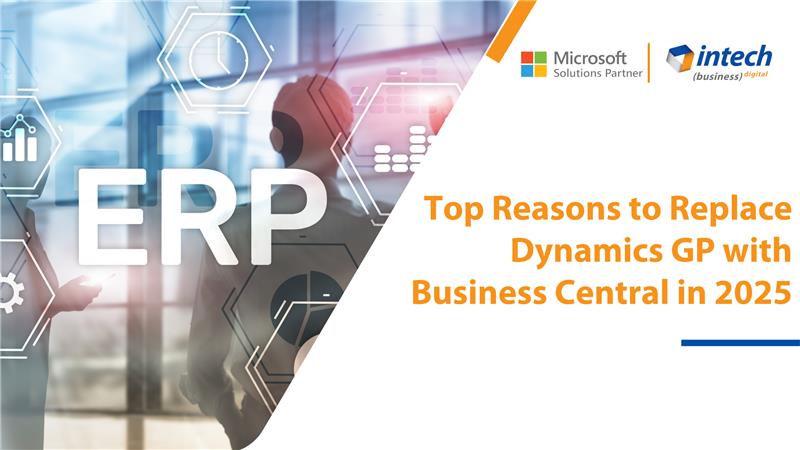Checklist to make your business GST ready
Intech’s ERP Solutions – Microsoft Dynamics AX and Microsoft Dynamics NAV are GST ready. The Goods and Services Tax (GST) Council has formally approved all the GST laws. The GST is expected to be implemented by end of July 2017.
With GST now in place, it is time for you to ensure you catch up to speed and seamlessly adapt it in your business as other taxes such as VAT, Excise, service tax, etc. will disappear giving way to one single Tax. GST would bring in significant changes to business processes. Depending on the operating size, geographies, and sector, the changes would be substantial and may require proactive planning with a time-bound action plan.
To make it a point that you’re GST ready, Look into this checklist to see if your business is geared up for this change:
1. Understand your business process in GST scenario and classify which transactions are goods and services.
These transactions will be most affected by GST. Integrated Goods and Services Tax (IGST) model of taxation has been adopted for interstate transactions where Center would levy IGST which would be CGST plus SGST. Make sure that you thoroughly understand and bifurcate your transactions. This will help you in understanding the overall impact of GST on your business.
2. Classify your transactions under goods and services, and place of provisions
After classifying the goods and services related transactions, recognize which provisions will be applicable to them. GST is a just broad topic which comprise of many provisions for various goods and services. These provisions differ with location, industry and type of commodity. Thus, identifying what will be applicable to your business beforehand will take you a step further in GST compliance.
3. Define the change in business in stages of pre, during and post manufacturing
GST is surely going to change almost all your processes – be it manufacturing, trade or supply chain. Reorganized manufacturing plants and warehouses would reduce the primary freight charges. GST would eliminate the existing penalties on interstate sales transactions and facilitate the consolidation of vendors and suppliers. Before GST sets in, make a calculation of how your various functions are going to change and operate.
4. Understand your logistics model – depot and branches.
GST is a destination based tax. There will be a greater impact on logistics and the charges/taxes levied. After GST implementation, your warehousing and logistics decision will be based on economic efficiency such as costs and locational advantages vis-a-vis key customers. You may have to strategize your supply management strategies in a manner that minimizes cash flow impact.
5. Define your sales policies – schemes, discounts and returns
Should you charge GST to your customers on the items or services you provide? Would your pricing still be competitive? All such questions are going to affect the selling price of your goods and service, discounts and returns you provide to your customers and other such pricing policies. Defining your sales policies in compliance with GST will help you maintaining your profit levels and customers.
6. Review your contracts – Amendment to current POs
Though GST is still few months away, make sure that you make the required amendments in your current POs and contracts. It is advisable to define the terms and conditions to meet GST requirements. will make your work easier in the future.
7. Review your suppliers – nature of goods, place of supply, contractual terms
Contract terms, not only with your customers but also with your suppliers need to be revised. With GST regime, the supply chain network design would be more flexible. GST would lead to club many small warehouses and have bigger, fewer, and highly efficient warehouses. Thus, changes have to be made in contracts with your current suppliers at various places. Make sure that you review your suppliers, what and where they supply and the mutual contracts.
Given the sparsity of time, being at the cutting edge of technology is now the only way to adopt this change smoothly. Want your business to be GST ready? Our team is here to help you navigate this change.
About Intech
Intech Systems is a three-cloud Microsoft-certified partner that boasts deep expertise in providing digital transformation solutions for organizations by leveraging the Microsoft 365, Dynamics 365, and Azure solution stack. Intech is recognized as a top-tier Microsoft implementation partner globally and specializes in transformative technology solutions such as ERP (Enterprise Resource Planning), CRM (Customer Relationship Management), Business Process Automation, Business Intelligence, Cloud Infrastructure, Data Management, Productivity & Collaboration and Generative AI (Gen-AI) solutions. As a trusted Microsoft Solutions Partner, we are capable of doing complex technology implementations catered to an organization’s specific needs & also rapid solution implementation such as our Microsoft Dynamics 365 Business Central implementation packages. We pair our implementations with end-to-end customer support, offshore development & 3rd party integrations. With offices in India, USA (United States of America), and Singapore, we work with clients across globe to empower businesses with cutting-edge technology solutions. Our latest services aim at delivering business ready AI solutions to the customer, like our Microsoft Copilot Consulting Services & Solutions for small, medium & large enterprises. Intech’s expertise lies in building software solutions for Manufacturing, Professional Services & Healthcare. Our Dealer Management System, Sales and Service CRM for Manufacturing, Field Force Automation for Pharmaceuticals and Manufacturing Central are some of our leading industry solutions. Intech’s vision is to catalyze digital futures for operation-centric industries globally, we are at the forefront of innovation, helping organizations drive growth and innovation like never before. Contact Us to learn more.
Recent Post




How can we help? - Talk to Dynamics 365 experts for your concerns
What's New

Top Reasons to Replace Dynamics GP with Business Central [2025]
Introduction: The clock is ticking for businesses still operating on Microsoft Dynamics GP. While it...

How AI Agents Are Redefining the Market Research Landscape
Do you know your competitors are decoding consumer behavior in hours using AI agents that...

How Agentic AI Is Transforming the Manufacturing Industry [2025]
Introduction Did you know that 91% of manufacturers are planning to increase their investment in...




